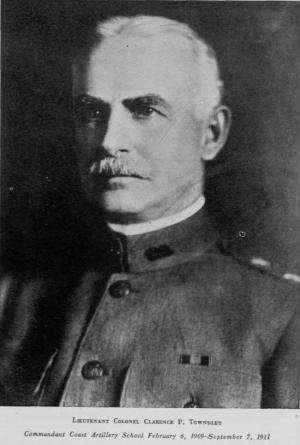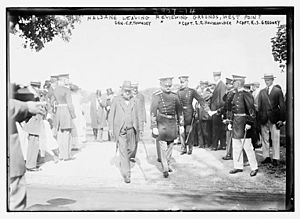Clarence Page Townsley facts for kids
Quick facts for kids
Clarence Page Townsley
|
|
|---|---|
 |
|
| Born | September 24, 1855 De Kalb, New York |
| Died | December 28, 1926 (aged 71) Washington, D.C. |
| Buried |
West Point Cemetery, West Point, New York
|
| Allegiance | |
| Service/ |
|
| Years of service | 1881–1918 |
| Rank | |
| Unit | United States Army Field Artillery Branch United States Army Coast Artillery Corps |
| Commands held | Pensacola Coast Artillery District U.S. Army Coast Artillery School Superintendent of the United States Military Academy 30th Division |
| Battles/wars | Spanish–American War World War I |
Clarence Page Townsley (September 24, 1855 – December 28, 1926) was an important officer in the United States Army. He spent his whole career serving his country. He even became the leader, or Superintendent, of the famous United States Military Academy at West Point.
Contents
Clarence Townsley's Early Life
Clarence P. Townsley was born on September 24, 1855, in De Kalb, New York. His family had a history of serving their community. His grandfather, Gideon, was a postmaster and a town leader. Clarence's father also served as postmaster and was elected to the New York State Assembly.
Clarence went to school at St. Lawrence Academy and the State Normal School in Potsdam. He then studied at Union College in Schenectady, New York, and graduated in 1876. For a year, he worked as a civil engineer in Sioux City, Iowa, helping to build a railroad.
In 1877, Clarence was accepted into the United States Military Academy at West Point. He graduated in 1881, ranking 14th in his class. He became a second lieutenant in the Field Artillery.
Military Career Highlights
Townsley began his military service with the 4th Field Artillery Regiment. After a short time in California, he returned to New York. He then served at several Coast Artillery bases. He also spent three years teaching drawing at West Point.
During the Spanish–American War, Townsley was in charge of the Ordnance office. This office handled weapons and supplies. He worked with the Fourth Army Corps in Huntsville, Alabama, and later in Havana, Cuba.
In 1905, Townsley took command of the Coast Artillery District in Pensacola. He was promoted to lieutenant colonel in 1909. After this, he led the Coast Artillery School and the Artillery District of Chesapeake Bay.
Leading West Point
In 1912, Clarence Townsley was chosen to be the Superintendent of the United States Military Academy. This is a very important leadership role. He was still the Superintendent when World War I began. He stayed in this position until July 1916. At that time, he was promoted to brigadier general.
World War I Service
As the U.S. Army got ready to join World War I, Townsley commanded the South Atlantic Coast Artillery District. He was then sent to the Philippines. There, he checked the artillery defenses in Manila and Subic Bay.
He was called back to the United States to train and lead the 30th Division. Townsley was promoted to temporary major general before taking his division to France. He later returned to the U.S. due to illness. He was on medical leave until just before the war ended in November 1918. He briefly commanded the North Pacific Coast Artillery District before retiring in December 1918.
Clarence Townsley passed away in Washington, D.C. on December 28, 1926. He was buried at West Point Cemetery in West Point, New York.
Townsley's Family Life
In 1891, Clarence Townsley married Marian Howland. They had three children: Marian, Helen Howland, and Clarence Jr. Helen Townsley later married Major General Leven Cooper Allen. Clarence P. Townsley Jr. also became a career officer in the U.S. Army, reaching the rank of brigadier general.


